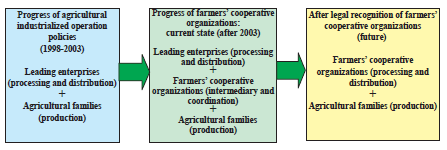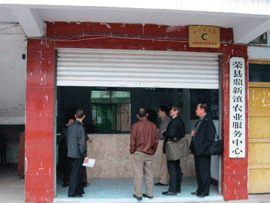Evaluation of functions of the agricultural social service system for stabilization of farm and rural management in China
Description
This is a shared research project at the Agriculture Economic Institute of the Chinese Academy of Agricultural Sciences. The project will be carried out from 2004 to 2008. The development of an agricultural social service system was designated as an important objective in the field of agriculture and rural areas set forth in the Decision of the 3rd Session of the 16th Congress of the Chinese Communist Party. The development of an agricultural social service system, along with direct subsidies and reduction and exemption of agricultural taxes, will lead to specific measures for the realization of increased farming incomes, and has become an important policy issue. Therefore, in 2004, taking as an example the major grain production area in the west, Zigong City in Sichuan Province, and that in the east, Zhangjiagang City in Jiangsu Province, we will carry out an analysis of the actual state of development of the agricultural social service system and specify directions for improvement. The research results thus far are as follows:
- An agricultural social service system means that social institutions provide, in various forms, agriculturalists with the various forms of economic and technical support required at different agricultural production stages. They include the following major components: (1) villagers’ committees, (2) farmers’ cooperative organizations (special associations and new cooperatives), (3) agribusiness organizations (leading enterprises), (4) agricultural technology popularization organizations, (5) rural economic support departments (supply and marketing cooperatives, rural credit cooperatives), and (6) others (agricultural insurance, and the like)
- Among the above components, farmers’ cooperative organizations will play a major role in the areas of economy and technology in the future. The reasons are that farmers’ cooperative organizations have no policy guarantees, so policy incentives have a greater effect and farmers’ cooperative organizations can act as intermediaries between processing and circulating enterprises and widely distributed agricultural families, allowing “leading enterprises + farmers’ cooperative organizations + agricultural families” to exert synergistic economic benefits.
- We are studying the potential for assistance by leading enterprises that pursue an “agribusiness” policy with integration of production and distribution.
Due to the widening of the gap between leading enterprises and agricultural families, the relationship between them shows a trend towards deadlock, in spite of it being possible for farmers’ cooperative organizations to become the main hub of integration for production and distribution. Our investigation results show that Chinese agricultural production and distribution modes have the potential to change significantly if farmers’ cooperative organizations are officially recognized as a result of legislative measures (Fig. 1). - The activities of agriculture and technology popularization organizations will be greatly affected by local government finance. In financially poor areas, the number of operation departments in popularization organizations (sales of production goods) has shown a tendency to increase. Ultimately, due to a widening gap between operations departments and technical direction departments, the financial status of the technical direction departments may further deteriorate.
- In the eastern coastal areas, farmers’ cooperative organizations frequently help to increase farming incomes by assisting the gaining of non-agricultural income from the real estate and distribution sectors. However, the following problems exist, whichever direction the regional economy in heading: (1) laws and regulations are not updated, (2) dependence on the government remains unchanged, (3) there are not enough participants (the participation rate is only 3-6% of agricultural families) and (4) there are few organizations concerned with major grain crops.
Figure, table
-
Fig. 1. Evolution of policies and major activity modes related to agricultural integration. -
Fig. 2. Visit to extension service office in Zigong City, Sichuan Province (township government).
- Affiliation
-
Japan International Research Center for Agricultural Sciences Development Research Division
- Classification
-
Technical B
- Term of research
-
FY2004(FY2004~2008)
- Responsible researcher
-
YAMASHITA Norihiro ( Development Research Division )
ZHAO Zhijun ( Institute of Agricultural Economics and Development, CAAS, China )
- ほか
- Publication, etc.
-
JIRCAS workshop on Mar. 2005 (To be published).
- Japanese PDF
-
2004_03_A3_ja.pdf523.64 KB


